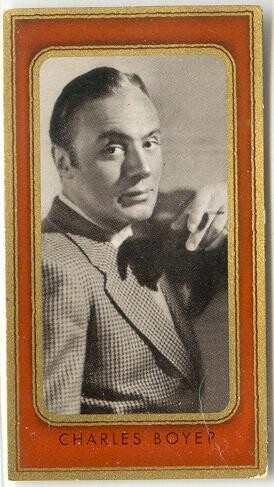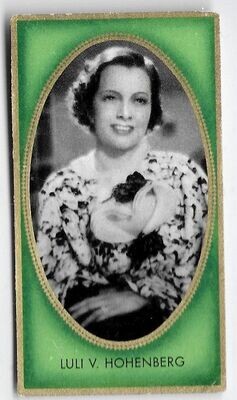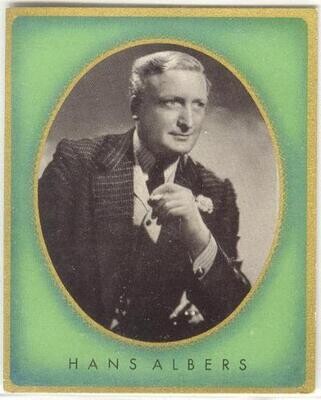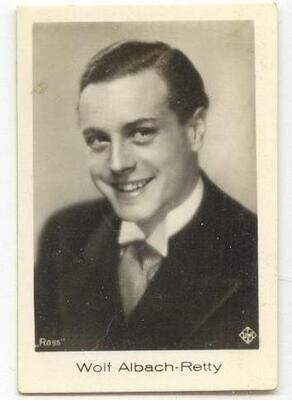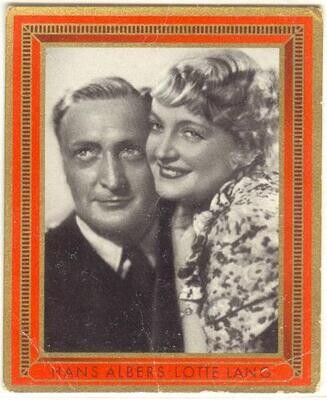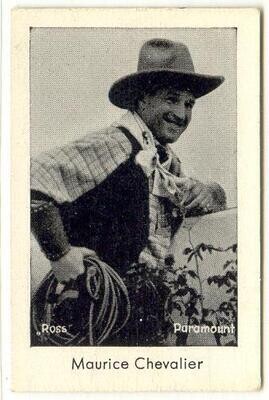
1936: Charles Boyer #105, last of cinema's great lovers
Charles Boyer ~ This lot is an original 1936 vintage card from the Bunte Filmbilder or Multicolored Film Pictures series of cigarettes cards. Card is #105. The card is about the same size as a traditional US/British cigarette card (just over 1¼" x 2¼"). The title of the series is a little misleading beause only the borders of these cards are in color, the photo is black and white. The example offered here is in very nice condition with very minor wear, see my scan. A very nice card: FINE
Born in Figeac, Lot, Midi-Pyrénées, France, the ultimate romantic ladies' man - suave and sophisticated beyond any woman's wildest dreams - was just a shy small-town boy who discovered the movies and theater at the age of eleven. In the 1920s he was not only the most popular romantic leading man on the Paris stage but was steadily employed in silent films. He went to Hollywood to make the European remake of Wallace Beery's great American movie, The Big House (1930). Since he had been such a big star in France he was taking a great risk by leaving the French film industry. He fell for Hollywood and decided to stay to take his chance in American films. With the coming of sound, his deep voice made him the perfect romantic star. Metro-Goldwyn-Mayer signed him to a contract and kept him busy, and once sound came in he made foreign-language versions of US hits for overseas distribution while he polished his English.
His first big break in a Hollywood role was a very small part of a chauffeur to Jean Harlow in Red-Headed Woman, 1932. In 1935, he starred in the psychiatric drama Private Worlds, and although the film was not a huge success, Charles Boyer was. He went on to play opposite the most alluring actresses of the 1930s and 1940s such as Katharine Hepburn and Claudette Colbert. Boyer continued making European films, and Mayerling (1936) made him an international star. Onscreen he made women swoon as he romanced Marlene Dietrich in The Garden of Allah (1936), Greta Garbo in Conquest (1937), and Irene Dunne in Love Affair (1939).
In 1938, he landed his famous role, as Pepe Le Moko, the thief on the run, in Algiers. Although he never invited costar Hedy Lamarr to "Come with me to the Casbah", the line would stick with him, thanks to generations of impressionists. Boyer's role as Pepe Le Moko was already world famous when animator Chuck Jones based the character of Pepe le Pew, the romantic skunk introduced in 1945's Odor-able kitty, on Boyer and one of his most well-known performance.
Boyer is best known for his role in the 1944 film Gaslight in which he tried to convince Ingrid Bergman's character that she was going insane. He became famous for his whispered declarations of love in movies with Garbo, Dietrich or Bergman. And in the 1940s he was the voice of Capt. Daniel Gregg in Lux Radio Theater's presentation of The Ghost and Mrs. Muir. In 1943, he was awarded a Honorary Oscar Certificate for "progressive cultural achievement" in establishing the French Research Foundation in Los Angeles. He never won an Oscar for acting, though he was nominated four times in Conquest (1937), Algiers (1938), Gaslight (1944) and Fanny (1961).
Boyer's career lasted longer than any other romantic male of his era, earning him the title "the last of the cinema's great lovers."
This lot consists of a genuine German cigarette premium issued between about 1930 and 1937. In general, German cigarette cards and premiums make an interesting and inexpensive addition to any collection. The Nazi government of Germany opposed smoking and eventually put an end to cigarette cards. As a result, the native German card collecting hobby never developed to the extent of that in Britain or the United States. As a result, most German premiums and cards cost only a fraction of what might be expected from their American and British cousins.
Large photos are shown smaller than actual size while small ones are generally enlarged to as much as twice their original size. Almost all photos and cards are scanned through protective sleeves or pages which tends to cut the clarity a bit. Enlarged defects tend to look worse than they actually are.
